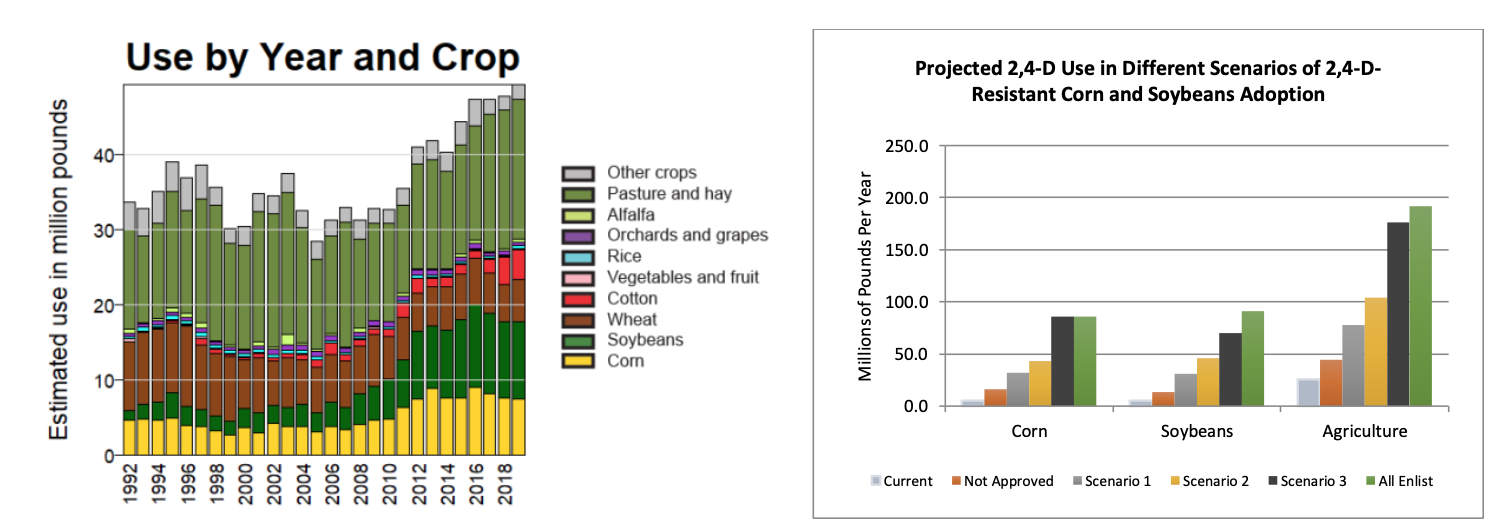What is it?
2,4-dichlorophenoxyacetic acid (2,4-D) is one of the oldest synthetic biocides. Originally developed (though not used) as a chemical warfare agent in World War II, it was later deployed as part of the defoliant, Agent Orange, in the Vietnam War. 2,4-D kills broadleaf (flowering) plants in agriculture, primarily in pastures, corn, soybeans, wheat, and cotton.

Fig. 1. U.S. Geological Survey, e-Pest-High (left)
Fig. 2. Projected 2,4-D use with Dow 2,4-D-resistant corn and soybeans, based on data from Dow AgroSciences (now Corteva) (right)
Since the early 2000s, farm use of 2,4-D has climbed by 50%, to 50 million lbs. per year, to kill glyphosate-resistant weeds spurred by the Roundup Ready crop system (Figure 1). Further sharp increases in 2,4-D use are coming as more farmers plant genetically engineered (GE) soybeans, cotton, and corn resistant to both 2,4-D and glyphosate, and spray it with Enlist Duo, which contains both (Figure 2). Another 11-15 million lbs./year of 2,4-D are applied to lawns, golf courses, and in other non-agricultural settings.
Dioxins in 2,4-D
Dioxins are highly toxic compounds that cause cancer, reproductive problems, and hormonal disruption. They were major contaminants of Agent Orange, and lower levels of dioxins are still found in some 2,4-D formulations.
Human health threats
Farmers who apply 2,4-D have a greater risk of hypothyroidism, or deficiency of thyroid hormones that can cause joint and muscular pain, fatigue, impaired memory, and many other adverse effects, supported by similar findings in animal studies. Disruption of thyroid hormones may also explain the smaller head circumference found in male newborns exposed to 2,4-D in utero. 2,4-D-exposed farmworkers had more sperm abnormalities and dead sperm than unexposed men, while another study correlated increasing exposure to 2,4-D with reduced testosterone levels. Occupational exposure to 2,4-D and other chlorophenoxy herbicides is associated with higher rates of the immune system cancer non-Hodgkin lymphoma as well as Parkinson's disease. Finally, rodent studies by 2,4-D maker Dow show that long-term exposure to small amounts of 2,4-D cause kidney degeneration.
Environmental harms
2,4-D has long been a leading culprit in drift damage to crops. 2,4-D injures grapevines an incredible 10 and even 50 miles away from the nearest sprayed field, while even supposedly "low volatility" 2,4-D sprayed on GE crops drifts to damage cotton fields. There is occasionally enough 2,4-D and other herbicides in rainfall to injure beans and tomatoes. And it is not only crops that are injured. By selectively killing or suppressing reproduction of flowering plants, 2,4-D drift can change plant communities, favoring annual weeds and grasses over native plants. Areas adjacent to fields treated with 2,4-D and other herbicides have fewer flowering plant species than those of organically managed fields, fewer butterflies, and less diverse populations of birds, small mammals, and insects.
Honeybee larvae are easily killed by 2,4-D, as are ladybugs. EPA reports that dozens of threatened and endangered species—including plants, fish, butterflies and the rusty patched bumble bee—will be jeopardized by Enlist Duo, unless farmers implement certain mitigation measures of unproven efficacy.
CFS in action
Scientists and Center for Food Safety (CFS) detailed the human health and environmental harms of 2,4-D and Enlist Duo in multiple sets of comments, and CFS led farmers and environmental groups in two lawsuits against EPA alleging violation of pesticide law and the Endangered Species Act in its approval of the herbicide. In 2020, a federal Court ruled that EPA had not properly considered Enlist Duo's risks to monarchs via its effects on milkweed plants essential to their survival.

